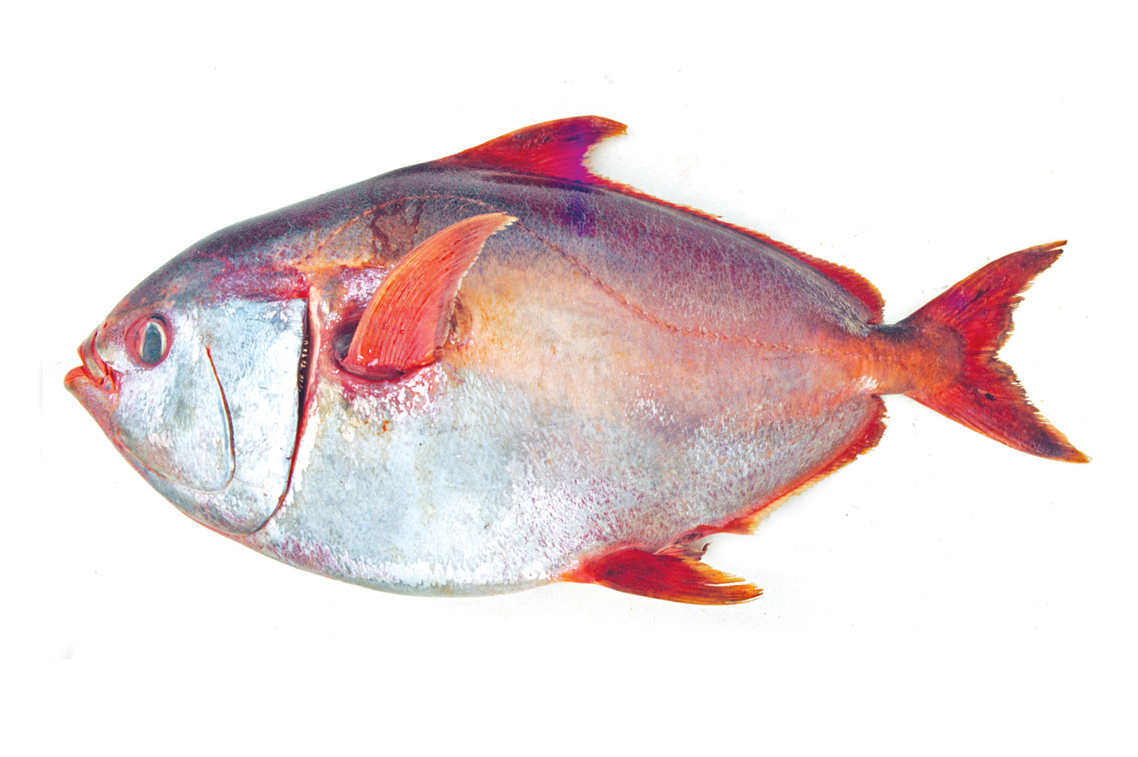- Classification
- ACTINOPTERYGII
- LAMPRIDIFORMES
- LAMPRIDAE
- Lampris
- immaculatus
Southern Moonfish, Lampris immaculatus Gilchrist 1904

Southern Moonfish, Lampris immaculatus. Source: Australian National Fish Collection, CSIRO. License: CC by Attribution-NonCommercial
A large oval-shaped pelagic fish with a dark silvery-blue body above, paler below, and bright red fins.
Moonfish are rare oceanic fishes found throughout cooler waters of the Southern Hemisphere. A considerable amount of plastic was found in the stomachs of Lampris immaculatus in the Southern Ocean (Jackson et al. 2000).
Southern Moonfish, Lampris immaculatus Gilchrist 1904
More Info
|
Distribution |
Epi- and mesopelagic in temperate and cold temperate waters of the Southern Hemisphere. In Australian waters, recorded from off southern Tasmania, in depths of 50-485 m. |
|
Features |
Dorsal fin 49-56; Anal fin 32-40; Pectoral fin 21-24; Pelvic fin 12-15; Gill rakers 13-14; Vertebrae 43. Body much longer than deep, depth 1.9-2.3 in SL; head length 2.9-3.6 in SL; pectoral-fin length 4.8-5.4 in SL; pelvic-fin length 4.1-6.6 in SL. Pelvic-fin origin at or behind mid-body; caudal fin slightly forked. Body covered in small, cycloid, deciduous (easily-shed) scales. |
|
Size |
To a maximum total length of 125 cm. |
|
Colour |
Body a dark silvery-blue or bluish-grey overlain with a metallic sheen above; silvery-grey with a reddish overlay below straight part of lateral line; snout reddish; fins bright orange with paler margins. |
|
Feeding |
Feeds mostly mesopelagic squids, along with mesopelagic fishes and krilll. Individuals in the Southwest Atlantic also consume significant amounts of plastic (Jackson et al. 2000). |
|
Fisheries |
Although not targeted, the species is taken and retained as bycatch in commercial longline tuna and billfish fisheries, and also in trawl fisheries. |
|
Remarks |
Southern Moonfish appear to follow fishing boats to feed on targeted species, which may impact their foraging behavior, and cause considerable ingestion of plastic (Jackson et al. 2000). |
|
Similar Species |
The other species in the genus found in Australian waters Lampris australensisand L. megalopsis, are deeper-bodied, have longer pectoral and pelvic fins, and silvery-white spots on the body. |
|
Etymology |
The specific name immaculatus is from the Latin im-, (= not) and maculata, (= spotted), in reference to the lack of white spots on the body unlike Lampris guttatus |
|
Species Citation |
Lampris immaculata Gilchrist, 1904, Mar. Investig. South Africa 3: 4, pl. 22. Type locality: beach at Muizenberg, False Bay, South Africa |
|
Author |
Bray, D.J. 2020 |
|
Resources |
Southern Moonfish, Lampris immaculatus Gilchrist 1904
References
Duhamel, G., Gasco, N. & Davaine, P. 2005. Poissons des îles Kerguelen et Crozet. Guide régional de l'océan Austral. Collection Patrimoines Naturels 63, Muse´um National d’Histoire Naturelle, Paris, 419 pp
Gilchrist, J.D.F. 1904. Descriptions of new South African fishes. Marine Investigations in South Africa 3: 1-16 18 pls
Gon, O. 1990. Lampridae (pp. 215-217). In Gon, O. & P.C. Heemstra (eds) Fishes of the Southern Ocean. J.L.B. Smith Institute of Ichthyology, Grahamstown, South Africa.
Heemstra, P.C. 1986. Family No. 117: Lampridae. In Smith, M.M. & P.C. Heemstra (eds). Smiths’ sea fishes. Macmillan South Africa, Johannesburg, 398pp.
Jackson G.D., N.G. Buxton, N.G. & George, M.J.A. 2000. The diet of the southern Opah Lampris immaculatus on the Patagonian Shelf; the significance of the squid Moroteuthis ingens and anthropogenic plastic. Marine Ecology Progress Series 206: 261-271 doi:10.3354/meps206261
Moore, J. 2019. Lampris immaculatus. The IUCN Red List of Threatened Species 2019: e.T123373847A123376503. https://dx.doi.org/10.2305/IUCN.UK.2019-2.RLTS.T123373847A123376503.en. Downloaded on 17 June 2020.
Olney, J.E. 1999. Families Veliferidae, Lamprididae, Stylephoridae, Lophotidae, Radiicephalidae, Trachipteridae, Regalecidae. pp. 1966-1975 in Carpenter, K.E. & Niem, V.H. (eds). The Living Marine Resources of the Western Central Pacific. FAO Species Identification Guide for Fisheries Purposes. Rome : FAO Vol. 3 1397-2068 pp.
Palmer, G. & Oelschläger, H.A. 1976. Use of the name Lampris guttatus (Brünnich, 1788) in preference to Lampris regius (Bonnaterre, 1788) for the opah. Copeia 1976(2): 366-367.
Parin, N.V. & Kukuyev, Ye.I. 1983. Re-establishment of the validity of Lampris immaculata Gilchrist and the geographical distribution of the Lampridae. Journal of Ichthyology 23(1): 1–12.
Stewart, A.L. 2015. 91 Family Lampridae (pp. 684-686), in Roberts, C.D., Stewart, A.L. & Struthers, C.D. 2015. The Fishes of New Zealand. Wellington : Te Papa Press Vol. 3 pp. 577-1152.

